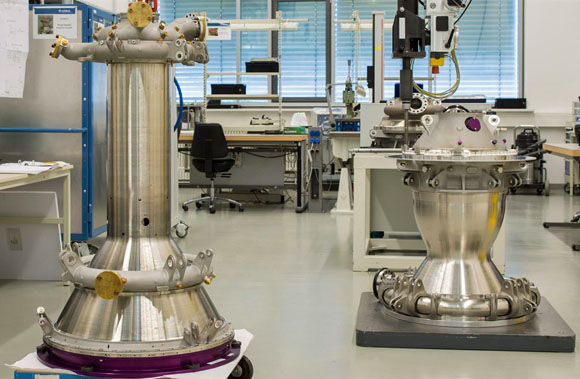Production begins on new Ariane 6 Vinci thrust chambers incorporating metal AM components
July 12, 2017

Vinci thrust chambers for the new Ariane 6 (Courtesy DLR)
The latest generation of the Ariane space rocket launcher, scheduled to enter service in 2020, will reportedly offer an increased payload carrying capacity and the flexibility to perform a wide range of missions with high reliability. Production has now begun on the rocket’s Vinci engine at ArianeGroup (formerly Airbus Safran Launchers) in Ottobrunn, Germany. The Vinci engine, which is incorporated in the upper stage of Ariane 6, will take over thrust capacity once the rocket has escaped Earth’s gravitational field using its main stage and solid fuel boosters. The engine has been designed to be both energy-efficient and reignitable, crucial for ensuring optimal propulsion in space.
Both Additive Manufacturing and Powder Metallurgy are used to manufacture components in the Vinci engine, which the engine’s designers report improve cost and time efficiency. “These two methods have substantial advantages compared to cast or forged products, as components involving complex structures can be produced in large numbers, without the need for mechanical reworking,” stated Denis Regenbrecht, who is responsible for the Ariane programme at the DLR Space Administration, Germany. “The elimination of expensive manufacturing stages and simplification of the engine structure have cut the costs significantly.”
Cost-efficiency measures like this are said to be imperative to the production of all space tech, which must be economically viable as competition to provide space-faring technologies increases and economic support is withdrawn. “European launcher systems face growing levels of competition in global markets,” continued Regenbrecht, “which will intensify the price pressure in future. Ariane 6 is a response to this situation, as its launch costs will be approximately half of what they were with its European predecessor, Ariane 5.”
The Vinci engine’s main body will be produced in Vernon, France, by ArianeGroup, while the combustion chamber is being produced in Germany. Vinci uses cryogenic hydrogen (LH2: – liquid hydrogen at minus 253°C) as its fuel, and cryogenic oxygen (LOX – liquid oxygen at minus 180°C) as its oxidiser, after the expander cycle. First the fuel flows around the combustion chamber, cooling it down and evaporating. The gases produced by this process are used to drive turbopumps, which force the oxidiser and fuel into the combustion chamber, where they are burned together with the additional oxidiser.
With its 79 successful launches, Ariane 5 is reportedly amongst the most reliable launch vehicles ever built. The engines of Ariane 6 have been tested carefully to ensure the safe transport of payloads into space, with further tests ongoing at the DLR Institute of Space Propulsion in Lampoldshausen, Germany.
















